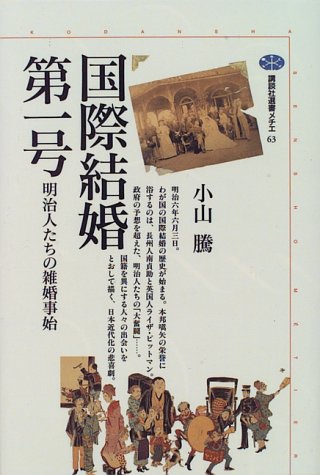14 0 0 0 IR 明治前期国際結婚の研究 : 国籍事項を中心に
- 著者
- 小山 騰
- 出版者
- 慶應義塾福澤研究センター
- 雑誌
- 近代日本研究 (ISSN:09114181)
- 巻号頁・発行日
- vol.11, pp.121-173, 1994
国際結婚リストはじめに国際結婚の最初の照会太政官布告第103号太政官布告第103号に対する各国の反応国際結婚許可の手続国際結婚関係の史料および国際結婚の推定総数国際結婚の最初の事例尾崎三良とパサイア・モリソンの結婚と離婚英国人が関係した早期の事例皇族と国際結婚外国人婿養子の一事例としての「快楽亭ブラック」の結婚国籍による国際結婚の分析おわりに
1 0 0 0 OA 近隣住民ネットワークの国際比較研究
- 著者
- 大内 田鶴子 玉野 和志 林 香織 鰺坂 学 廣田 有里 小山 騰 ディアス ジム 斎藤 麻人 吉田 愛梨 細淵 倫子 清野 隆
- 出版者
- 江戸川大学
- 雑誌
- 基盤研究(B)
- 巻号頁・発行日
- 2016-04-01
グローバリゼーション下、地域社会と市民・近隣組織に関する新たな理論枠が必要になっている。本研究は新しい社会に対応する近隣組織について実態を把握し、論点を整理した。1.イングランドでは自治会規模の住民組織が準自治体となっている。2.シアトル市ではボトムアップ式の協議体を設置し、合意形成能力を獲得し、その後政治対立に巻き込まれ機能不全に陥った。3.シアトル近郊の極小自治体の長期存続は、住民の凝集性の維持につとめたこと、コモンズの維持管理を行っていることなどによる。4.個人が情報のコントロール力を持ちつつある現在、ITによる意見交換の仕組みと個人の情報発信のスキルが必要であることが明らかになった。
1 0 0 0 国際結婚第一号 : 明治人たちの雑婚事始
1 0 0 0 OA アーサー・モリソンと日本
- 著者
- 小山 騰
- 出版者
- 日本英学史学会
- 雑誌
- 英学史研究 (ISSN:03869490)
- 巻号頁・発行日
- vol.1995, no.27, pp.75-87, 1994 (Released:2010-01-27)
- 参考文献数
- 41
Arthur Morrison (1863-1945) is known as an English novelist who described the lives of the poor in the East End of London realistically around the turn of the century. His major works are “Tales of Mean Streets”, “A Child of the Jago”, “The Hole in the Wall”, etc. Although Morrison never went to Japan, he was also a keen collector and scholar of Japanese art (Japanese woodcut prints and paintings). Morrison wrote “The Painters of Japan” in 1911 which was regarded as indispensable contribution to Japanese art studies for around fifty years. His collections of Japanese prints and paintings which his studies of Japanese art were based upon have become parts of Japanese art collections at the British Museum. This essay examines how Arthur Morrison developed his interests and studies on Japanese prints and paintings through the contacts with Japanese people in London, such as Kumagusu Minakata, Kanzan Shimomura, Tokuboku Hirata and his friendship with W. E. Henley, Harold Parlett, Laurence Binyon. This essay also focuses on what Morrison gained personally from his studies of Japanese art, particularly Japanese prints (Ukiyoe) and his contacts and friendship with Japanese people in London. Through my study of Morrison's analogy between the Ukiyoe painters in the history of Japanese art and himself as regards their subjects, methods, etc., it can be concluded that Morrison might have received stronger influence from Japanese art than what is usually thought.
